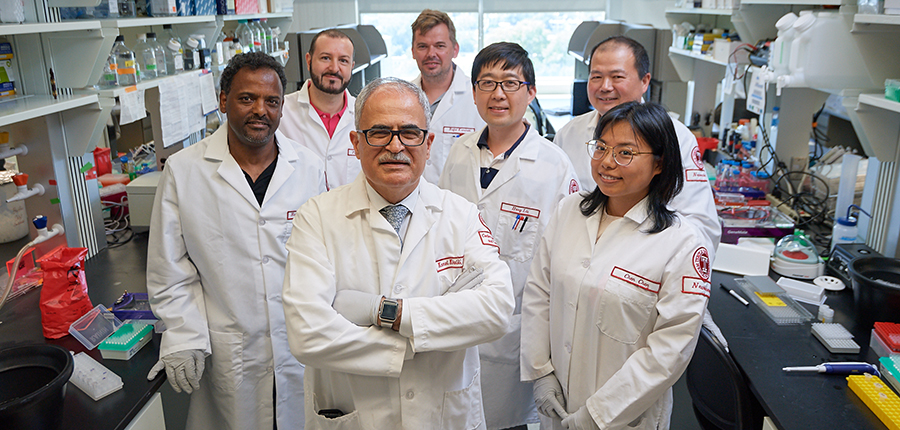
In a major collaborative effort, researchers at the Lewis Katz School of Medicine at Temple University and the University of Nebraska Medical Center (UNMC) have for the first time eliminated replication-competent HIV-1 DNA – the virus responsible for AIDS – from the genomes of living animals. The study, reported online July 2 in the journal Nature Communications, marks a critical step toward the development of a possible cure for human HIV infection.
“Our study shows that treatment to suppress HIV replication and gene editing therapy, when given sequentially, can eliminate HIV from cells and organs of infected animals,” said Kamel Khalili, PhD, Laura H. Carnell
Professor and Chair of the Department of Neuroscience, Director of the Center for Neurovirology, and Director of the Comprehensive NeuroAIDS Center at the Lewis Katz School of Medicine at Temple University (LKSOM). Dr. Khalili and Howard Gendelman, MD, Margaret R. Larson Professor of Infectious Diseases and Internal Medicine, Chair of the Department of Pharmacology and Experimental Neuroscience and Director of the Center for Neurodegenerative Diseases at UNMC, were senior investigators on the new study.
“This achievement could not have been possible without an extraordinary team effort that included virologists, immunologists, molecular biologists, pharmacologists, and pharmaceutical experts,” Dr. Gendelman said. “Only by pooling our resources together were we able to make this groundbreaking discovery.”
Current HIV treatment focuses on the use of antiretroviral therapy (ART). ART suppresses HIV replication but does not eliminate the virus from the body. Therefore, ART is not a cure for HIV, and it requires life-long use. If it is stopped, HIV rebounds, renewing replication and fueling the development of AIDS. HIV rebound is directly attributed to the ability of the virus to integrate its DNA sequence into the genomes of cells of the immune system, where it lies dormant and beyond the reach of antiretroviral drugs.
In previous work, Dr. Khalili's team used CRISPR-Cas9 technology to develop a novel gene editing and gene therapy delivery system aimed at removing HIV DNA from genomes harboring the virus. In rats and mice, they showed that the gene editing system could effectively excise large fragments of HIV DNA from infected cells, significantly impacting viral gene expression. Similar to ART, however, gene editing cannot completely eliminate HIV on its own.
For the new study, Dr. Khalili and colleagues combined their gene editing system with a recently developed therapeutic strategy known as long-acting slow-effective release (LASER) ART. LASER ART was co-developed by Dr. Gendelman and Benson Edagwa, PhD, Assistant Professor of Pharmacology at UNMC.
LASER ART targets viral sanctuaries and maintains HIV replication at low levels for extended periods of time, reducing the frequency of ART administration. The long-lasting medications were made possible by pharmacological changes in the chemical structure of the antiretroviral drugs. The modified drug was packaged into nanocrystals, which readily distribute to tissues where HIV is likely to be lying dormant. From there, the nanocrystals, stored within cells for weeks, slowly release the drug.
According to Dr. Khalili, “We wanted to see whether LASER ART could suppress HIV replication long enough for CRISPR-Cas9 to completely rid cells of viral DNA.”
To test their idea, the researchers used mice engineered to produce human T cells susceptible to HIV infection, permitting long-term viral infection and ART-induced latency. Once infection was established, mice were treated with LASER ART and subsequently with CRISPR-Cas9. At the end of the treatment period, mice were examined for viral load. Analyses revealed complete elimination of HIV DNA in about one-third of HIV-infected mice.
“The big message of this work is that it takes both CRISPR-Cas9 and virus suppression through a method such as LASER ART, administered together, to produce a cure for HIV infection,” Dr. Khalili said. “We now have a clear path to move ahead to trials in non-human primates and possibly clinical trials in human patients within the year.”
Other researchers contributing to the study include Rafal Kaminski, Ramona Bella, Taha M. Ahooyi, Chen Chen, Pietro Mancuso, Rahsan Sariyer, Pasquale Ferrante, Martina Donadoni, Jake A. Robinson, Ilker K. Sariyer, Tricia H. Burdo, Won-Bin Young, Shohreh Amini, Jennifer Gordon, and Jeffrey M. Jacobson, Department of Neuroscience, Lewis Katz School of Medicine at Temple University; Prasanta K. Dash, Hang Su, Saumi Mathews, Brady Sillman, Zhiyi Lin, James R. Hilaire, Mary Banoub, Monalisha Elango, R. Lee Mosley, Larisa Y. Poluektova, JoEllyn McMillan, Aditya N. Bade, and Santhi Gorantla, Department of Pharmacology and Experimental Neuroscience, UNMC; and Nagsen Gautam, Department of Pharmaceutical Sciences, College of Pharmacy, UNMC.
The research was supported in part by grants awarded by the National Institutes of Health to Temple University and to UNMC, including R01MH104147, R01NS36126, R01NS034239, P01NS43985, P30MH062261, P30AI078498, R01AG043540, P30MH092177, P01DA037830, R01MH110360, R01DA013137, R01NS087971, R24OD018546, and R01DA42706.
Editor’s Note: Dr. Khalili is a named inventor on patents that cover the CRISPR/CAS9 system viral gene editing technology. In addition, Dr. Khalili is a co-founder, scientific advisor, member of the Board of Directors, and has received equity and monetary compensation from Excision BioTherapeutics, a biotech start-up which has licensed the viral gene editing technology from Temple University for commercial development and clinical trials. Drs. Gendelman and Edagwa are named inventors on patents that cover the LASER ART technology. Dr. Gendelman also is the founder and chief scientific officer of Brain First, Inc. Drs. Khalili and Gendelman have not received financial compensation from any other third parties for any aspects of this published work.
